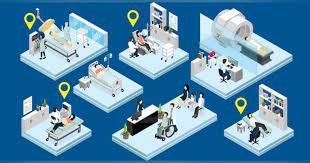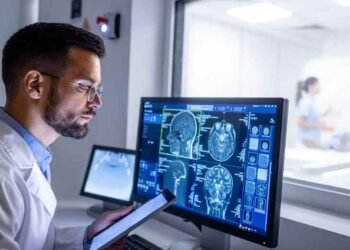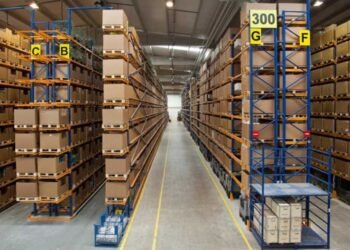Real-Time Location System (RTLS) technology has significantly impacted transforming medical practices and saving lives. RTLS utilizes technologies such as RFID (Radio Frequency Identification), GPS (Global Positioning System), Bluetooth, and Wi-Fi to track and locate assets, people, and equipment in real-time within a defined space. When applied to medical settings, RTLS offers precise tracking and monitoring capabilities that enhance efficiency, patient safety, and overall healthcare outcomes.
Here are some ways in which RTLS for hospitals has revolutionized medical practices:
Asset and Equipment Tracking:
In healthcare facilities, efficiently locating and managing medical equipment and assets is crucial. RTLS enables real-time equipment tracking like infusion pumps, ventilators, defibrillators, and wheelchairs, reducing equipment loss, theft, and unauthorized usage. Staff can quickly locate necessary equipment, improving workflow and emergency response times.
With RTLS, healthcare providers can optimize their workflow by reducing the time spent searching for equipment. Staff members can quickly locate the nearest available equipment, leading to improved efficiency and productivity. Also, RTLS helps prevent equipment loss and theft by providing constant monitoring and real-time alerts. If an item is moved or leaves a designated area without authorization, the system can trigger an alarm, ensuring immediate action to prevent loss or theft.
Patient Tracking and Workflow Optimization:
Patient tracking and workflow optimization are key benefits of implementing RTLS technology in healthcare settings. For instance, RTLS enables healthcare providers to track patients in real time as they move through the hospital or clinic. This information helps identify bottlenecks in patient flow and optimize the allocation of resources, such as staff and equipment, to reduce wait times and improve overall efficiency.
With RTLS, healthcare staff can monitor patient locations and estimated wait times, allowing them to address delays and optimize patient scheduling proactively. This helps minimize waiting times, enhancing patient satisfaction and experience.

Staff Safety and Communication:
Staff safety and communication are paramount in healthcare settings, and RTLS technology is crucial in enhancing both. Healthcare RTLS systems often include panic buttons or wearable devices that healthcare staff can activate in emergency situations. These panic buttons trigger immediate alerts, notifying security personnel or designated responders about the distress call and the exact location of the staff member in need. This enables a rapid and targeted response, ensuring staff safety during critical events.
Furthermore, RTLS can detect and respond to emergencies by monitoring staff movements and activities. In the event of a critical incident, such as a fall, a sudden stoppage in movement, or prolonged inactivity, the system can automatically generate alerts to designated personnel or security teams. These real-time alerts provide instant awareness of potential emergencies and enable prompt response, enhancing staff safety and reducing the risk of adverse outcomes.
Infection Control and Asset Utilization:
RTLS aids infection control efforts by monitoring hand hygiene compliance. By tracking staff movements, the system can identify instances when proper handwashing or sanitization protocols are not followed. This data helps enforce infection control policies, reducing the risk of healthcare-associated infections. RTLS also provides insights into asset utilization, allowing healthcare organizations to optimize equipment allocation and maintenance schedules.
Workflow Efficiency and Patient Safety:
Implementing RTLS technology in hospitals and clinics significantly enhances workflow efficiency and patient safety.
RTLS provides real-time visibility into various aspects of workflow, such as patient locations, staff availability, and equipment status. This information allows healthcare providers to monitor the overall flow of patients and resources, identify bottlenecks or delays, and take proactive measures to address them promptly.
Also, RTLS can trigger alerts and notifications based on predefined rules and workflows. For example, it can notify staff when a patient has been waiting for an extended period, reminding them to provide timely care and attention. These alerts ensure that critical tasks and procedures are completed on time, reducing delays, preventing missed opportunities for intervention, and improving patient outcomes.
Surgical Instrument and Medication Management:
RTLS technology is crucial in surgical instrument and medication management, ensuring patient safety and streamlining processes. RTLS enables the tracking and management of surgical instruments throughout their lifecycle, from sterilization to utilization. By attaching RFID or other tracking tags to instruments, healthcare providers can accurately monitor their location and availability in real time.
Besides, RTLS assists in the automatic inventory management of surgical instruments. The technology can track usage patterns, sterilization cycles, and maintenance history, enabling healthcare facilities to optimize instrument allocation and minimize the risk of shortages or overstocking. This streamlines inventory control, reduces costs, and ensures surgical teams have the necessary tools for each procedure.
Key Takeaway
RTLS technology has transformed medical practices by providing real-time visibility, precise tracking, and efficient management of assets, patients, and staff. By optimizing workflows, improving patient safety, and enhancing communication, RTLS saves lives and delivers better healthcare outcomes. As technology advances, we can expect further innovations and applications that will revolutionize the healthcare industry.












